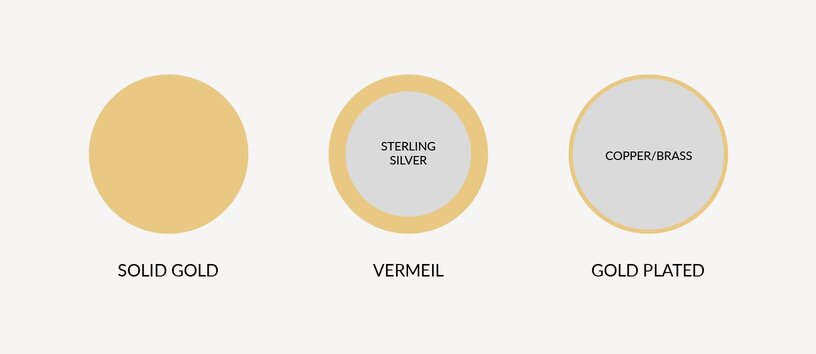The Difference Between Plated, Vermeil, & Solid Gold
the benefits of investing in solid gold jewelry
Gold has long captivated humanity with its allure and timeless elegance. In the realm of jewelry, the distinction between 14K Gold Plated, Vermeil, and Solid Gold often leads to confusion. Let’s uncover the characteristics, benefits, and disparities among these variations to help you navigate the world of golden adornments.
14k gold plated
When an item is labeled as 14K Gold Plated, it means that a base metal (such as brass or copper) has been coated with a thin layer of gold via electroplating. The “14K” denotes the purity of the gold used in plating, indicating it contains 58.3% pure gold.
Pros:
Affordable: 14K Gold Plated jewelry is relatively inexpensive compared to solid gold.
Variety: Allows for a wide range of designs and styles due to its affordability.
Cons:
Durability: The gold plating can wear off over time, exposing the base metal underneath.
Maintenance: Requires careful handling and occasional re-plating to maintain its appearance.
14k gold vermeil
Vermeil (pronounced ver-MAY) is a step up from gold plating. It involves a thicker layer of gold—usually 2.5 microns—applied onto sterling silver, which serves as the base metal.
Pros:
Quality: Offers a higher gold content than gold plated items, lending it a more luxurious appearance.
Durability: The thicker gold layer makes Vermeil more resistant to tarnishing and wear in comparison to gold plating.
Cons:
Maintenance: While more durable than gold plating, Vermeil jewelry still requires gentle care to preserve its appearance and the plating can wear off.
Cost: Vermeil jewelry tends to be more expensive than plated jewelry due to the thicker gold layer and the use of sterling silver as the base metal (silver is considered a more precious metal than brass or copper).
solid 14k gold
Here at Olive Ave, we only use solid 14k gold jewelry! Solid Gold jewelry is made entirely from the precious metal itself. The purity of gold is measured in karats (abbreviated as "K" or "k"), with 24K being pure gold. The American standard for gold is 14K because it holds up to wear better (24K is too soft). 14K gold is pure gold mixed with other metals to add strength. A setting or band made purely of 14K gold is considered solid gold. White gold is usually rhodium plated for a shiny white appearance but is still considered "solid gold" as the ring is cast entirely in 14K gold even though it has this light plating applied after casting.
Pros:
Durability: Solid Gold is highly resistant to tarnishing, corrosion, and wear.
Longevity: Solid Gold pieces retain their value and appearance over time, often becoming family heirlooms.
Cons:
Cost: Solid Gold jewelry is the most expensive due to its precious metal content.

in summary
While each type of gold jewelry has its own merits, the choice ultimately depends on personal preference, budget, and desired longevity. 14K Gold Plated and Vermeil offer affordability and aesthetic appeal, while Solid Gold embodies enduring quality and value.
Understanding the nuances among these variations empowers you to make an informed decision when selecting your next piece of golden adornment, ensuring that your choice resonates with both your style and your budget.
